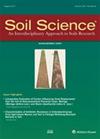生物炭促进土壤团聚体稳定性和有机碳固存,调控土壤微生物群落结构
4区 农林科学
Q2 Agricultural and Biological Sciences
引用次数: 1
摘要
摘要自20世纪50年代以来,由于大量耕作,再加上有机质摄入不足,导致东北地区土壤严重退化。生物炭与肥料结合使用是一种改善土壤质量的可持续方法。本文通过田间试验,探讨了土壤团聚体稳定性机制、有机碳动态特性和微生物群落结构变化对生物炭的响应。生物炭投入水平为C1、C2和C3(分别为9.8、19.6和29.4 Mg C ha - 1),施氮量为N /2 (300 kg N ha - 1)和N (600 kg N ha - 1)。结果表明,生物炭配施氮肥可有效提高土壤碳储量和团聚体稳定性(P2 mm和0.25-2 mm),分别提高56.59%和23.41%。磷脂脂肪酸(PLFA)分析显示,生物炭配施氮肥能有效改善土壤微生物群落结构(P<0.05)。在c2n2 /2处理下,F/B比提高了25.22%,革兰氏阳性(Gm+)与革兰氏阴性(Gm−)比提高了4.65%。本研究的结论是,软土对生物炭的反应主要是由团聚体、有机碳和微生物的相互作用决定的。因此,在最佳施肥比下,生物炭与氮肥配合施用可能会减缓Mollisols的土壤退化,但其潜在机制仍需进一步探索。本研究将为贻贝资源的保护和可持续利用提供科学依据。本文章由计算机程序翻译,如有差异,请以英文原文为准。
Biochar promotes soil aggregate stability and associated organic carbon sequestration and regulates microbial community structures in Mollisols from northeast China
Abstract. Since the 1950s, heavy plowing of Mollisols, combined
with a lack of organic matter intake, has resulted in severe soil
degradation in northeast China. The use of biochar in combination with
fertilizer is a sustainable method of improving soil quality. In this paper,
we conducted field experiments to explore the response of the stability
mechanism of the soil aggregate, the dynamic properties of organic carbon,
and changes in the microbial community structure to biochar. The biochar
input levels were C1, C2, and C3 (9.8, 19.6, and 29.4 Mg C ha−1,
respectively), while the nitrogen (N) fertilizer rates were N1/2 (300 kg N ha−1) and N (600 kg N ha−1). Results indicated that biochar
combined with N fertilizer effectively increases soil carbon storage and
aggregates stability (P<0.05). And C2N treatment increased the
aggregate contents of the >2 mm and 0.25–2 mm fractions by
56.59 % and 23.41 %, respectively. The phospholipid fatty acid (PLFA)
analysis revealed that microbial community structure was effectively
improved with biochar combined with N fertilizer application (P<0.05). The F/B ratio increased by 25.22 % and the gram-positive
(Gm+) to gram-negative (Gm−) ratio by 4.65 % under the C2N1/2
treatment. This study concluded that the response of Mollisols to biochar is
primarily determined by the interplay of aggregate, organic carbon, and
microorganisms. Therefore, the use of biochar combined with N fertilizer
might mitigate soil degradation of Mollisols under an optimal application
ratio, but the underlying mechanism still requires further exploration. This
study will provide a scientific basis for the conservation and sustainable
utilization of Mollisols resources.
求助全文
通过发布文献求助,成功后即可免费获取论文全文。
去求助
来源期刊

Soil Science
农林科学-土壤科学
CiteScore
2.70
自引率
0.00%
发文量
0
审稿时长
4.4 months
期刊介绍:
Cessation.Soil Science satisfies the professional needs of all scientists and laboratory personnel involved in soil and plant research by publishing primary research reports and critical reviews of basic and applied soil science, especially as it relates to soil and plant studies and general environmental soil science.
Each month, Soil Science presents authoritative research articles from an impressive array of discipline: soil chemistry and biochemistry, physics, fertility and nutrition, soil genesis and morphology, soil microbiology and mineralogy. Of immediate relevance to soil scientists-both industrial and academic-this unique publication also has long-range value for agronomists and environmental scientists.
 求助内容:
求助内容: 应助结果提醒方式:
应助结果提醒方式:


